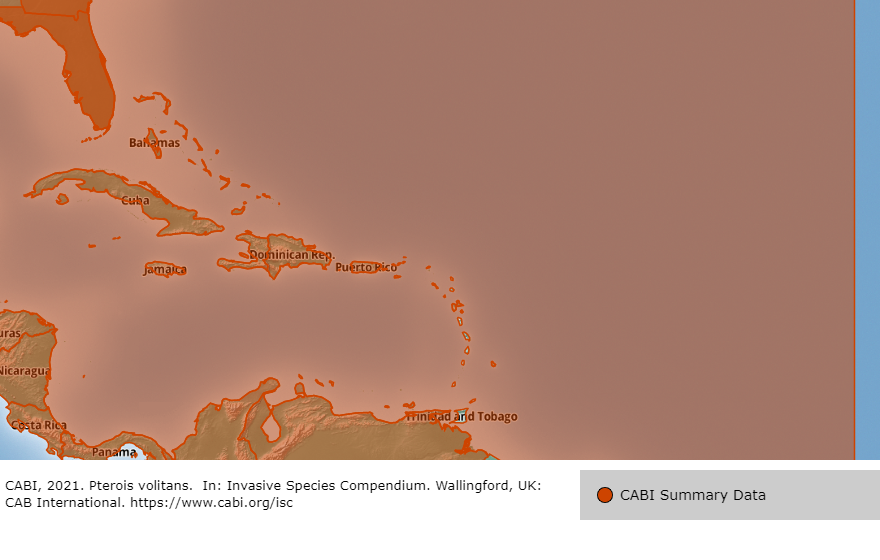History of Introduction
The lionfish is a native of the Indo-Pacific region and the Red Sea and is popular in aquariums. The most accepted theory of their introduction into the Atlantic is from intentional and unintentional release from Aquariums and hobbyists in Florida and North Carolina. Released fish reproduced rapidly, spreading south to Florida then to The Bahamas.
DESCRIPTION
The Red Lionfish can grow to an adult size of more than 17 inches. The body is relatively thick and has alternating vertical white, brown or maroon stripes. The head has small spikes and fleshy growths above the eyes and below the mouth. The pectoral fin is a distinctive fan shape and the dorsal spines are long and separated. The dorsal, pelvic and anal spines are venomous.
DIET
In their native range the diet of the Lionfish consists of small and juvenile fish, shrimps and crabs. In the Bahamas, they have demonstrated to be effective predators with an insatiable appetite. They will eat nearly any fish or crustacean that fit into their mouths and this includes the juvenile fish of several species notably the Nassau Grouper (Epinephelus striatus), Blennies, Wrasses, Squirrelfish, Silversides, Cardinalfish, Sea Basses, Hamlets, Basslets, Goatfish, Flounders. Juvenile crawfish and octopi among many others have also been eaten by Lionfish in the Bahamas.
REPRODUCTION
Lionfish breed year round independent with tides or lunar cycles. Reproduction can occur every 3-4 days during the late afternoon or early evening. The usually solitary fish will congregate in groups to mate. For 3 to 4 days the males will pose and show off to prospective mates, darting around and thrusting at rival males. When impressed, the female will pick her mate and begin a courtship display where both fish circle above the sea floor and spiral upwards. Near the surface the female will release a gelatinous ball of about 30,000 eggs and in turn the male will roll upside down and release his sperm into the ball. Then the two fish depart and Red Lionfish the eggs hatch in 1 or 2 days. The larvae are thought to be pelagic and in three months they have grown into miniature adults that are light in colour and almost transparent.
HABITAT
Lionfish reside in shallow water to depths of more than 500 feet. They can be found anywhere there are holes, crevices, overhangs or artificial structures in the seabed. This can be on coral reefs, patch reefs, seagrass areas, shipwrecks, marinas, mangroves and in canals. However, they tend to prefer artificial structures and low lying reefs in the Bahamas.
DISTRIBUTION
The Red Lionfish is native to the Indo-Pacific and Red Sea region which includes such countries as Australia, Polynesian Islands, China and Sri Lanka. They have now invaded the waters off the East coast of the US from as far north as New York and as far south as Florida and into The Bahamas. They are also now throughout most of the Gulf of Mexico and The Caribbean, with the most recent sighting in Trinidad & Tobago.
CONSERVATION CONCERN
The Lionfish in The Bahamas is a very successful invader as it has few natural predators, an abundant food source and it can reproduce very quickly, double the eggs it produces in its native habitat. This has resulted in a population explosion. Being the voracious predator that it is, it is competing with native, commercially important fish such as groupers and snappers. They prey on the juvenile fish as well as compete with the adults for food.
INTERESTING FACTS
Other common names include Lionfish, Turkeyfish, Zebrafish, Red Firefish, Peacock Lionfish, Butterfly Cod, Scorpian Volitans. Another species known as the Devil Firefish (P. miles) is thought to have invaded the Bahamas along side the Red Lionfish, however they are not easily distinguishable. Lionfish are not poisonous, but are venomous. This means that the meat is good to eat but the venom is confined in the spine. When stuck by a spine of a lionfish, an intense throbbing and sharp pain soon follows. Other symptoms include redness and swelling around the wound, sweating, blistering, headaches, seizures, chills , cramps, nausea, vomiting and a tingling sensation around the affected area that can last days even weeks. To treat, immerse the area in water as hot as bearable and seek medical attention. The hot stream of water from an outboard engine is a convenient source of hot water that can be used. Painkillers can also be administered to reduce the intensity of the venom. Lionfish are considered a food delicacy in Asia. They can be safely eaten in The Bahamas and have a similar taste to grouper and hogfish. To clean a Lionfish, the dorsal, pelvic and anal spines need to be removed carefully and the fish scaled and gutted or the meat can be filleted straight off of the fish.
Distribution Map (CABI ISC):

